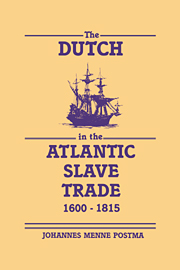Book contents
- Frontmatter
- Contents
- List of tables, figures, and maps
- Preface
- 1 Foundations of the slave traffic, 1600–61
- 2 Curaçao and the asiento trade, 1650–1730
- 3 The Dutch on the West African coast
- 4 Trade and politics on the African coast
- 5 Volume of African exports and origins of slaves
- 6 Organization and mechanics of the trade
- 7 The triangular trade
- 8 The Dutch plantation colonies under WIC monopoly, 1618–1738
- 9 The era of the free trade, 1730–80
- 10 The slaves: their treatment and mortality
- 11 Finances, marketing, and profitability
- 12 The end of the Dutch slave trade, 1781–1815
- Appendixes
- Bibliography
- Index
9 - The era of the free trade, 1730–80
Published online by Cambridge University Press: 16 September 2009
- Frontmatter
- Contents
- List of tables, figures, and maps
- Preface
- 1 Foundations of the slave traffic, 1600–61
- 2 Curaçao and the asiento trade, 1650–1730
- 3 The Dutch on the West African coast
- 4 Trade and politics on the African coast
- 5 Volume of African exports and origins of slaves
- 6 Organization and mechanics of the trade
- 7 The triangular trade
- 8 The Dutch plantation colonies under WIC monopoly, 1618–1738
- 9 The era of the free trade, 1730–80
- 10 The slaves: their treatment and mortality
- 11 Finances, marketing, and profitability
- 12 The end of the Dutch slave trade, 1781–1815
- Appendixes
- Bibliography
- Index
Summary
In contrast to their European competitors, the Dutch were slow in replacing company monopoly with free trade in the Atlantic slave trade. The French in 1672 and the English in 1689 permitted their nationals to participate freely in the slave trade on condition that they pay a certain fee, 10 percent in case of the English subjects. Hence, they were often referred to as the 10-percent men. By the end of the 1720s, when the WIC charter was due for its customary thirty-year renewal, the Dutch States General also bowed to pressure from the private sector and curtailed the WIC monopoly so drastically that it essentially inaugurated the free-trade period with the new WIC charter of 1730.
The free trade triumphs
The Atlantic trade monopoly of the WIC had slowly been eroded throughout the seventeenth century, first in Brazil and in North America, and in specific branches of commerce; however, the slave trade had been retained by the company as one of the last vestiges of company control. There had been discussions as early as the 1660s to open the slave trade to private merchants. This had come to nothing, and in the WIC reorganization in 1674 the slave trade was perhaps even more firmly under the company's monopoly than before.
- Type
- Chapter
- Information
- The Dutch in the Atlantic Slave Trade, 1600–1815 , pp. 201 - 226Publisher: Cambridge University PressPrint publication year: 1990

